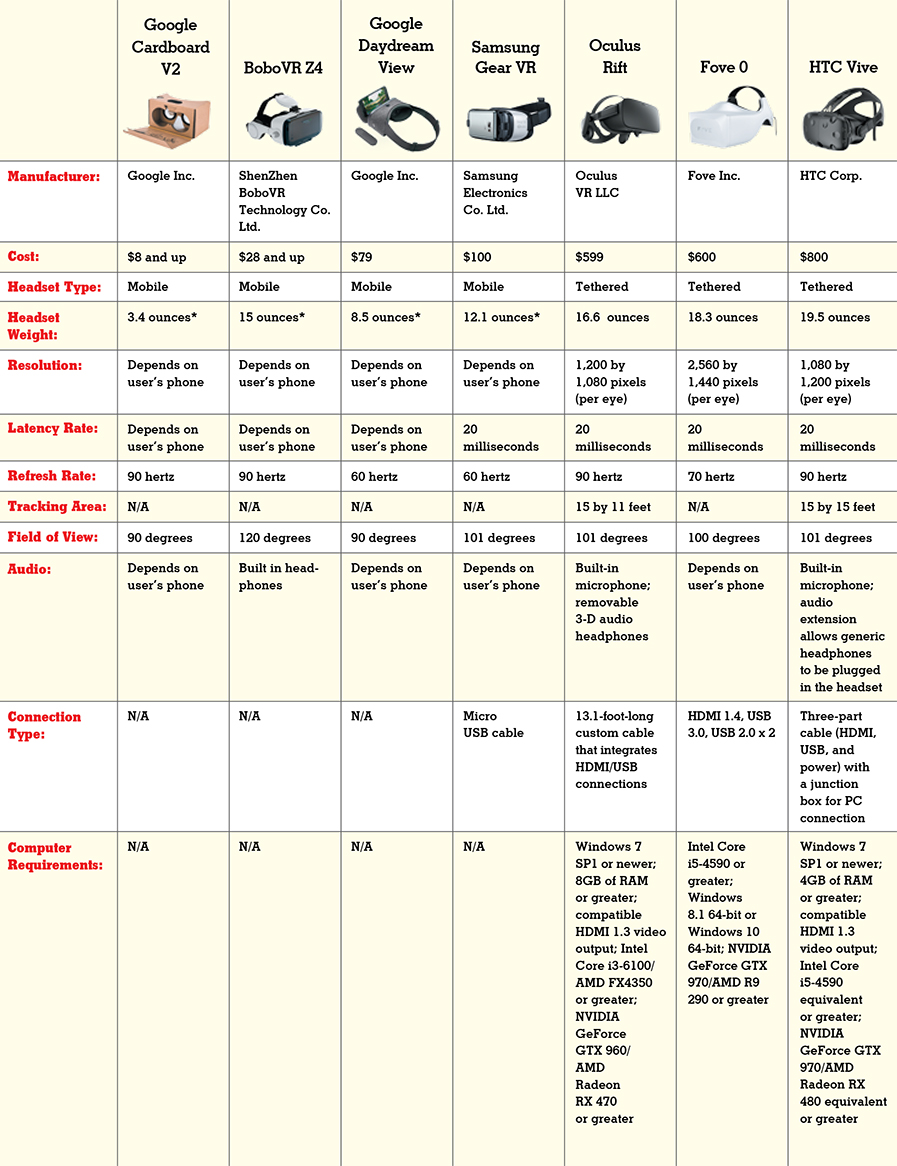|
REGISTRATION REQUIRED
technology
Reality Bytes
From shoemaker Merrell's hike over treacherous mountain terrain to hotelier Marriott International Inc.'s relaxing "teleportation" to a blissful Hawaii beach, companies are using virtual reality (VR) to provide unreal experiences – all offered within an exhibit or event setting. While there are dozens of systems that produce VR experiences, here are seven headsets in particular that will have your attendees entering enchanted worlds faster than Alice can fall into Wonderland.
By Charles Pappas
 The easiest and cheapest way to experience VR content, Google Inc.'s updated Cardboard headset works with most Android and iOS phones with screen sizes ranging from 3.5 to 6 inches. Users simply install the free Google Cardboard app on their smartphones, then mount the device to the cardboard headset. Making the experience seamless is a Near-Field Communication (NFC) chip embedded in the headset that automatically launches the app whenever users slide the phone into the headset. A capacitive touch button on the top allows users a limited ability to interact with what they see on the phone's screen through the headset's adjustable lenses. Additionally, the Cardboard Camera app turns smartphones into VR cameras. To date, more than 5 million Cardboard headsets have shipped, making it the most popular entry in the VR world, a status fueled by the more than 10,000 apps available for it. PROS: ➤ Cheapest VR headset available ➤ Multiple versions available on the official website ➤ Easy setup ➤ Compatible with many smartphones ➤ Thousands of apps available CONS: ➤ Resolution depends on the user's smartphone ➤ Unit's less-sophisticated lenses cannot render movement, depth, or immersive experiences as well as more powerful tethered systems  An intriguing alterative to Google's more mainstream and better-known Cardboard and Daydream View, the ShenZhen BoboVR Technology Co. Ltd.-made BoboVR Z4 offers several high-end advantages with a decidedly down-scale price tag. Like the Google devices, the BoboVR Z4 works with smartphones that have a screen size ranging from 4 to 6 inches, which drop into a hatch on the front of the headset. The lightweight device fits comfortably over eyeglasses, but what sets this one apart are its adjustable 35mm lenses, so that even the most nearsighted of users should be able to avoid wearing their glasses. Capable of running the same apps as Google Cardboard, the device comes with built-in headphones, a volume dial, and a control button. Best of all, depending on the size of the smartphone screen used, the BoboVR Z4 supplies an astonishing 120-degree field of view that literally expands the virtual world for users. PROS: ➤ Relatively inexpensive ➤ Easy setup ➤ Integrated audio system ➤ Compatible with many types of smartphones ➤ Adjustable 35mm lenses allow nearsighted users to enjoy a glasses-free VR experience ➤ Larger field of view can exceed that of Vive and Oculus Rift CONS: ➤ Resolution depends on the user's smartphone ➤ Unit's less-sophisticated lenses cannot render movement, depth, or immersive experiences as well as more powerful tethered systems  Debuting late in 2016, the Google Daydream View VR headset is an upscale version of Google Cardboard. Made from a light, breathable fabric, it fits comfortably over most eyeglasses. Similar to Cardboard, it works by dropping a compatible smartphone into a slot located on the front of the headset. Using a laser-pointer-like controller that tucks into the headset when they're not using it, users can, for example, swing a bat like Babe Ruth or cast a spell like Harry Potter in some of the various programs available. Currently the compatible phones for Daydream View include Google's Pixel X and Pixel XL, although other manufacturers will ship Daydream View-ready phones based on the Android Nougat operating system this year. The headset also runs apps and games that can be downloaded from the Google Play Store, while other Google services, such as YouTube and Street View, have dedicated VR apps for the Daydream View. PROS: ➤ Relatively inexpensive ➤ Easy setup ➤ Lightweight headset made of soft fabric ➤ Requires only a smartphone ➤ Three-axis control allows more sophisticated interaction than Google Cardboard ➤ Netflix, YouTube, Hulu, CNN, and The New York Times offer content CONS: ➤ Resolution depends on the user's smartphone ➤ Unit's less-sophisticated lenses cannot render movement, depth, or immersive experiences as well as more powerful tethered systems ➤ Only works with a limited number of smartphones (although more are expected soon)  Developed in partnership with Oculus VR LLC, Samsung Electronics Co. Ltd.'s Gear VR is an affordable VR system that merges aspects of less expensive and more upscale offerings. Like Daydream View, it's compatible with a select group of smartphones (Samsung Galaxy Note7, Galaxy S7, Galaxy S7 edge, Galaxy Note 5, Galaxy S6 edge+, Galaxy S6, and Galaxy S6 edge), which fit into a slot located in the side of the headset. Users plug in the headset's microUSB cable to the phone, which creates a high-speed connection that produces a low latency time that compares favorably with the higher-end Oculus Rift from Oculus VR LLC and HTC Corp.'s Vive. With more than 1,400 games and apps available through the Oculus Store, Samsung VR store, and Google Play Store (and many more anticipated), Gear VR stacks up well against the lower-priced but less-sophisticated Google Cardboard for sheer volume of content. PROS: ➤ Lower latency period than more expensive options ➤ Larger field of view than Google's Cardboard and Daydream View ➤ Extensive number of games and apps available CONS: ➤ Only works with a select number of Samsung phones ➤ Higher cost than other mobile VR headsets such as Google's Cardboard and Daydream View ➤ More than double the weight of Google Cardboard  Perhaps the best known of VR headsets, the Oculus Rift features a high-resolution display, integrated headphones, an oval-shaped control unit, and a cylindrical tracking camera set on an 8-inch-tall stand. Users download the Windows-based Oculus app on their PCs and then run through a brief setup while linking the Rift system to their computers. The Rift now ships with the new Oculus Touch controller ($199), which facilitates the precise manipulation of movement and action inside the 15-by-11-foot tracking area the system projects (i.e., the physical space the system can follow the user in). More geared to activities that take place seated than standing, the Rift can create a kind of private movie theater for Facebook 360, Twitch, and Vimeo videos, as well as users' own movie files. A wide variety of games, like the high-arenaline Project Cars series, are among the many software programs currently available. PROS: ➤ Comfortable fit, thanks to supportive foam padding around the eyes ➤ Over-the-ear headphones flip down into place from removable side mounts ➤ Built-in sensor automatically shuts off headset when you remove it ➤ Large assortment of games and other software now available CONS: ➤ More expensive than less sophisticated mobile VR headsets ➤ Smaller tracking area than that of HTC Corp.'s Vive ➤ Geared more toward seated activities than standing ones ➤ System requires a powerful processor and graphics card to operate effectively  The Fove 0 from Fove Inc. offers a handful of distinctive tweaks on the usual VR headset that set it apart from the rest of the pack. Inside the headset is an infrared sensor that tracks wearers' eyes, a unique feature that permits users to eschew a mouse or motion controls. That freedom from the standard mechanical controls lets users navigate games and make choices in VR programs just by focusing on a particular point with their eyes. Moreover, the sensor allows the unit to create visuals with a greater depth of field than many competitors' headsets offer, resulting in virtual worlds rendered with better accuracy and improved verisimilitude. Originating as a Kickstarter project and debuting in early 2017, the Fove 0 is compatible with approximately 250 of the SteamVR games and apps developed for HTC Corp.'s Vive. But stay tuned, as that roster of immersive programs is likely to rapidly expand in the year ahead. PROS: ➤ No mouse or motion controls needed ➤ Virtual worlds rendered with greater accuracy ➤ Integrated audio system ➤ Greater depth of field than many VR systems CONS: ➤ Limited number of compatible apps (more expected to be available soon) ➤ One of the most expensive mobile headsets available ➤ Lower refresh rate than the Vive or Oculus Rift  The HTC Vive system includes the requisite headset featuring an adjustable strap and lenses, but goes a step beyond the Oculus Rift with dual motion controllers and two base stations. The headset's high-resolution display offers a 110-degree field of view and 32 sensors for precise motion tracking. Its tracking area is about 35 percent larger than that offered by Oculus Rift. Meanwhile, two multifunction track pads with haptic feedback make it possible to "feel" objects in the 3-D environment it generates. Users can view friends' activities and chat with them from inside the headset via audio or text. Additionally, the Vive's front-facing camera offers users a quick view of the outside world without ever needing to remove the headset. The Vive's SteamVR operating system sidesteps the speed bumps of most VR headsets, such as delayed reaction to a user's movements and motion sickness resulting from said delays. PROS: ➤ Most lifelike environment of the seven VR systems reviewed here ➤ More than 250 games, apps, and programs available ➤ Users can see friends' activities and chat with them via the headset ➤ Possible to "feel" objects in the 3-D universe ➤ Larger tracking area than the Oculus Rift CONS: ➤ Most expensive of the systems reviewed here ➤ Headset weighs about 18 percent more than the Oculus Rift ➤ Requires a large amount of space to set up ➤ Requires a powerful processor and graphics card to operate effectively
Buyer's Guide
TERMS TO KNOW Mobile Headsets: Mobile headsets, such as Google Inc.'s Cardboard, rely on smartphones for both the display and processing of 3-D images. Once users slide a phone into a mobile headset's aperture, they can enjoy rudimentary interaction with the images they see by using a mechanical switch or a basic remote-control-like device. Latency: Latency – the delay you notice between when you move your head and when the image changes or updates appropriately on the screen to match your altered position – is a vital part of making any virtual experience seem real. While estimates vary, there is a general consensus that to create an environment nearly indistinguishable from reality, a VR system would need a latency rate of no greater than 15 milliseconds. Field of View: Field of view refers to how much of a scene a person's eyes take in out of a possible 360 degrees. The field of view for the average person runs about 180 degrees on a horizontal plane and about 135 degrees on a vertical one. The higher the field of view rating for a VR system, then, the closer it comes to what people experience in the real world. Refresh Rate: Displays running at a 90 hertz refresh rate are capable of showing 90 images per second, which is the generally accepted threshold for producing realistic visuals. The higher the refresh rate, the more authentic the virtual experience will be. 
|
|
|
||||||||||||||||||||||||||||
|
|
||||||||||||||||||||||||||||
|
TOPICS Measurement & Budgeting Planning & Execution Marketing & Promotion Events & Venues Personal & Career Exhibits & Experiences International Exhibiting Resources for Rookies Research & Resources |
MAGAZINE Subscribe Today! Renew Subscription Update Address Digital Downloads Newsletters Advertise |
FIND IT Exhibit Producers Products & Services All Companies Get Listed |
EXHIBITORLIVE Sessions Exhibit Hall Exhibit at the Show Registration |
ETRAK Sessions Certification F.A.Q. Registration |
EDUCATION WEEK Overview Sessions Hotel Registration |
CERTIFICATION The Program Steps to Certification Faculty and Staff Enroll in CTSM Submit Quiz Answers My CTSM |
AWARDS Exhibit Design Awards Portable/Modular Awards Corporate Event Awards Centers of Excellence |
NEWS Associations/Press Awards Company News International New Products People Shows & Events Venues & Destinations EXHIBITOR News |
||||||||||||||||||||
|
||||||||||||||||||||||||||||






